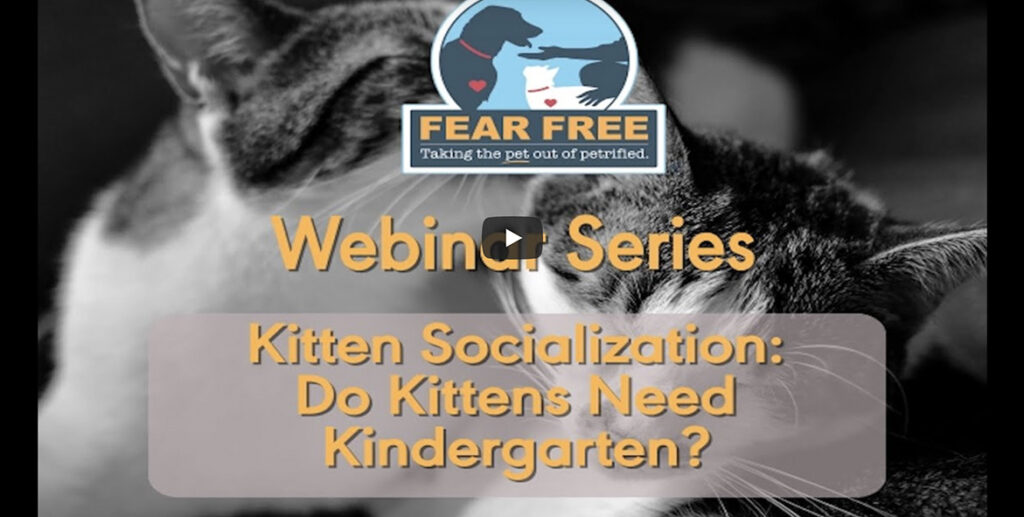Nancy PetersonSocialization prepares kittens to interact and be comfortable with people, other animals, objects, environments and activities. It can be very rewarding to turn hissing kittens into purring furballs.
However, when there are so many kittens who need homes, socializing those with the best chance of being adopted is important. Generally, the younger the kittens, the quicker they’ll socialize.
Kitten socialization can take from two to six weeks, depending on their age, personality inherited from their mother, friendliness inherited from their father and their early socialization experiences.
Although feral kittens can be weaned at 4 weeks of age, they have the best chance of survival with their healthy mom. For that reason, trap mom and her kittens when they’re 6 weeks old.
At that age, the kittens are still within the primary socialization window, from 2 to 7 weeks of age, when It’s easiest to socialize them. That said, older kittens may still come around since individuals develop at different rates.
Generally, feral kittens older than 16 weeks should be spayed/neutered, vaccinated, ear tipped (the universal sign of a spayed/neutered cat) and returned to their colony. That frees up cage space and staff time for younger kittens.
Housing the family apart from the general kitten population may be impractical, but options exist. Use a quiet one- or two-person office, which allows the family to become comfortable in an indoor environment and daily human activities.
Place a large wire crate with small openings (so kitten body parts don’t get stuck) on a table in the office. Include a hiding box, facing away from the front of the crate, in the crate. Cover the crate with a lightweight sheet that you retract as the family grows more secure.
Food is one of the best tools for socializing kittens. Kitten kibble should always be available, but toss in small, tasty morsels when you approach the crate so kittens and mom look forward to your presence.
When you feed wet food, first place the bowls toward the back of the crate; stay nearby when you provide wet food and treats to help create trust and positive associations with you. Move closer to the crate each time you feed. Then move the bowls closer and closer to the front of the crate and remain close.
If after three days, mom is still highly stressed and charges you when you approach the crate, spay, vaccinate, deworm, ear tip, and return her to her colony.
Older kittens who have learned to swat and bite and continue doing so 1 and a half weeks after removing mom should be spayed, vaccinated, ear tipped, and returned to their colony.
If the kittens are only hissing and spitting, carry on. However, if one isn’t coming around, house him in another location and work with him individually. You can return him to his siblings once he has progressed.
When they’re eating wet food at the front of the crate, try “petting” kittens on their face and chin with a toothbrush through the crate. Offer your bent forefinger through the crate near their bowl and see if they rub against it.
Don’t offer food on your finger or allow kittens to play with your hand. They may accidentally bite or scratch you, teaching them it’s okay to bite and scratch.
Since most feral kittens are initially frightened by interactive toys, start with one that isn’t too threatening, such as a wand toy, that allows you to play with them from a distance through the crate. Aim for small sessions, while talking on the phone or attending an online webinar, for a total of two hours a day.
Once the kittens allow you to touch them through the crate, try the following while they’re eating in the crate, but not after playing with them as they’ll be too worked up.
- Rest your hand in the crate.
- Put light pressure on their sides and gently move them from one food bowl to another.
- Put gentle pressure on their underside in preparation to being picked up.
- Lift them slightly, facing away from you, with both hands. Gradually lift them a bit longer and higher.
If there’s no struggling or tension, move one kitten at a time out the door; then quickly return him to the crate. Progress until you can lift the kitten out of the crate to a dish of food placed just beyond the door. If the kitten runs back into the crate, leave the crate door open and see if he ventures out on his own.
Once they’re comfortable outside the crate, briefly cuddle each kitten close to your body so they feel your warmth and heartbeat. When kittens are relaxed being held, cuddle them often. Once they seek your company, have other people provide treats and petting in preparation for the kittens’ adoption into a forever home.
If possible, adopt kittens in pairs or into a home with other friendly cats and no young children whose erratic movements and loud voices would be scary. Inform potential adopters that the kittens were feral and provide adopters with the resources listed at the end of this article so they understand the importance of socialization.
As with all new pets, adopted kittens should initially be confined to a kitten-proofed room with food, water, litter box, bed and toys. Hiding is normal and kittens shouldn’t be grabbed and dragged out. They can be lured with a toy onto their adopter’s lap.
Giving kittens time to adjust by talking, playing, petting and offering special treats will build trust and create a lasting bond.
Resources:
http://torontoferalcatcoalition.ca/wp-content/uploads/2014/07/10-the_behaviour_dept_taming_feral_cats.pdf
https://marketplace.animalsheltering.org/magazine/articles/kitty-their-hands\
https://www.psychologytoday.com/us/blog/animal-emotions/202003/the-cat-human-relationship-and-factors-affect-it
https://catvets.com/public/PDFs/PracticeGuidelines/FelineBehaviorGLS.pdf
This article was reviewed/edited by board-certified veterinary behaviorist Dr. Kenneth Martin and/or veterinary technician specialist in behavior Debbie Martin, LVT.
Nancy Peterson worked as a registered veterinary technician, trainer of dogs for people with disabilities other than blindness, and was Community Cats Program Manager for The Humane Society of the United States. She retired in 2015 and currently serves on the boards of Neighborhood Cats and The National Kitten Coalition. Nancy volunteers as a foster and cat cuddler for her local animal shelter, Colorado Animal Rescue (CARE). During COVID, she became an avid birder and is working to protect cats and birds by building bridges between cat and bird advocates.



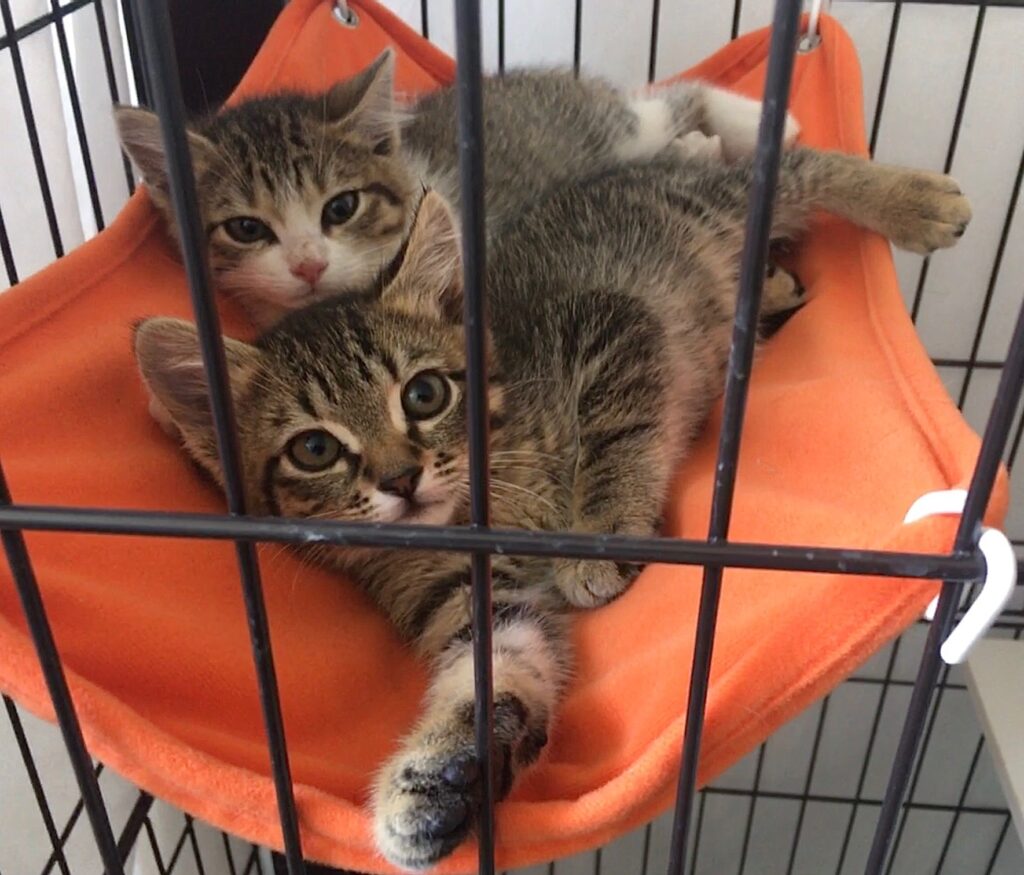
 their crate and train them together. A more frightened kitten may see her bolder littermate getting treats and decide you’re not so bad after all. On the other hand, it may incite aggression between kittens so observe carefully to determine whether to train them together or separately.
their crate and train them together. A more frightened kitten may see her bolder littermate getting treats and decide you’re not so bad after all. On the other hand, it may incite aggression between kittens so observe carefully to determine whether to train them together or separately.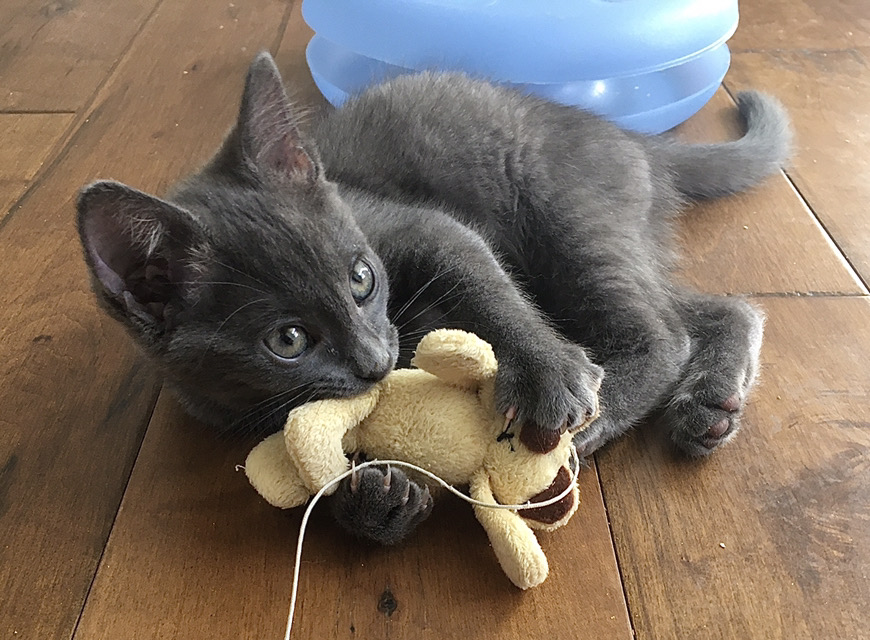


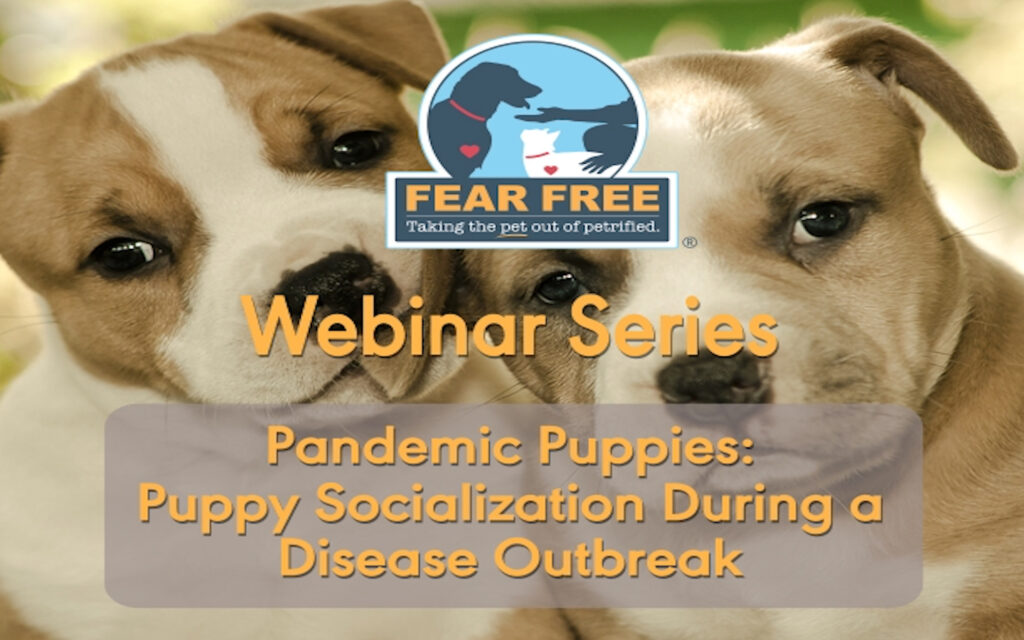
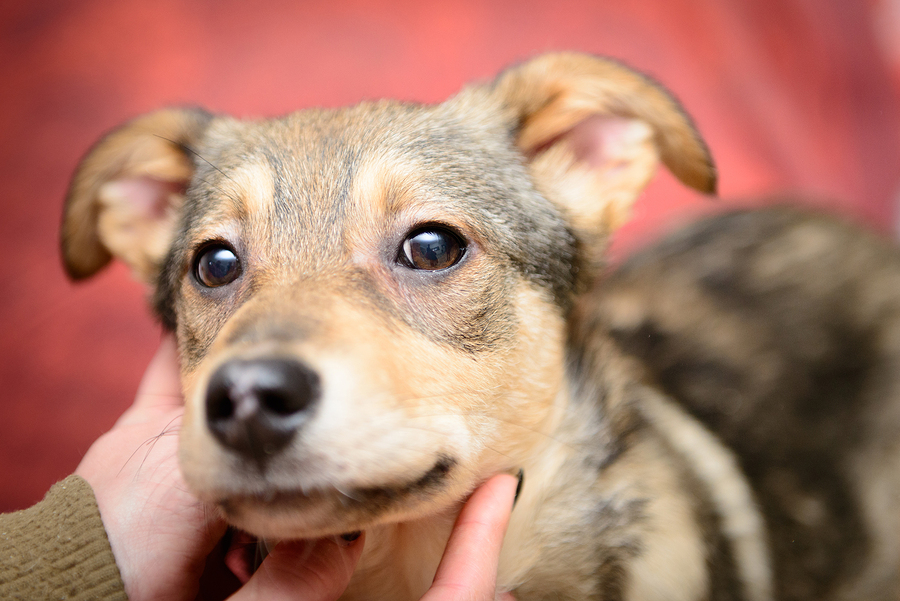
 year I’ve raised a pup following Summit’s training guidelines based on positive reinforcement and what puppies can handle at each developmental stage. Each pup explores the world in tiny increments based on what they tell me through body language about how the new environment feels to them. Sometimes we don’t even get out of the car if the pup seems to be hesitant. If they’re not ready for a new place, we go somewhere they have already been to build confidence. Each pup is born with unique strengths and levels of confidence. The big and bold ones move through environments more quickly than timid pups. My current pup, Jazz, came to me at 11 months of age. She was timid about change, so we moved slowly and calmly. We joined a scent work class, which allows the dogs to move freely at their own pace. This built her confidence quickly and now she rocks in almost any setting. Watching what your pet tells you through body language (relaxed, happy, withdrawn, cowering) is key to a truly Fear Free companion.
year I’ve raised a pup following Summit’s training guidelines based on positive reinforcement and what puppies can handle at each developmental stage. Each pup explores the world in tiny increments based on what they tell me through body language about how the new environment feels to them. Sometimes we don’t even get out of the car if the pup seems to be hesitant. If they’re not ready for a new place, we go somewhere they have already been to build confidence. Each pup is born with unique strengths and levels of confidence. The big and bold ones move through environments more quickly than timid pups. My current pup, Jazz, came to me at 11 months of age. She was timid about change, so we moved slowly and calmly. We joined a scent work class, which allows the dogs to move freely at their own pace. This built her confidence quickly and now she rocks in almost any setting. Watching what your pet tells you through body language (relaxed, happy, withdrawn, cowering) is key to a truly Fear Free companion. store when she was three months old. Early veterinary visits had caused her to become fearful. Medication didn’t help and she required heavy restraint. Her pet parents called our clinic about taking her on as it had been suggested that she might prefer a female veterinarian.
store when she was three months old. Early veterinary visits had caused her to become fearful. Medication didn’t help and she required heavy restraint. Her pet parents called our clinic about taking her on as it had been suggested that she might prefer a female veterinarian. Canasta is fearful of strangers and handling, which makes veterinary visits difficult for both Canasta and her caregiver. I recently started working with Canasta on basket muzzle training and being more comfortable with strangers, but she was in need of bloodwork immediately. Her veterinarian prescribed pre-visit pharmaceuticals, and I worked with the technician to create a handling plan and came to the visit to assist. When Canasta walked in wearing her basket muzzle, I used gentle control to restrain her while the technician drew blood. Canasta even took a treat from the technician when we were done, which is a huge win! Her mother was crying, knowing her dog did so well, and I will continue to work on cooperative care with the caregiver and Canasta.
Canasta is fearful of strangers and handling, which makes veterinary visits difficult for both Canasta and her caregiver. I recently started working with Canasta on basket muzzle training and being more comfortable with strangers, but she was in need of bloodwork immediately. Her veterinarian prescribed pre-visit pharmaceuticals, and I worked with the technician to create a handling plan and came to the visit to assist. When Canasta walked in wearing her basket muzzle, I used gentle control to restrain her while the technician drew blood. Canasta even took a treat from the technician when we were done, which is a huge win! Her mother was crying, knowing her dog did so well, and I will continue to work on cooperative care with the caregiver and Canasta.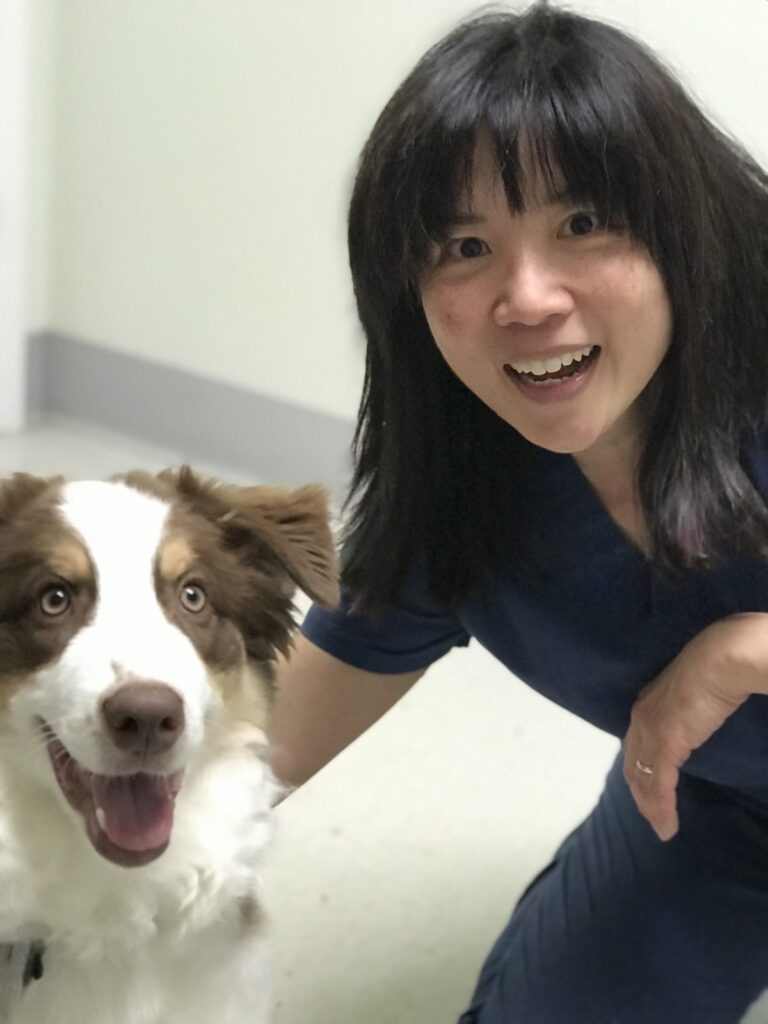
 I’m a Fear Free trainer, but there are no veterinarians I trust in my town, so I travel an hour to TLC Pet Hospital in Albuquerque and have had the most amazing experiences, thanks to the patience, kindness, and knowledge of the staff there. My dogs are fearful, and one is especially vet-phobic after traumatic experiences elsewhere. Some of his past vet visits have been so anxiety-inducing for him that I also end up in tears. But with gabapentin on board and the Fear Free approach from Dr. Long and Sam the veterinary assistant, my dog was wagging, approaching them, licking their faces, asking for pets, and acting like the brave and social dog he is at home. All of us in the room were floored by the change! At the next checkup he took food from them, did some chin-rest stationing with them, targeted their hands, and showed off his tricks. My own fear, anxiety, and stress levels have been drastically reduced thanks to their dedication to Fear Free vet visits. I’ll continue to do the two-hour round trip because I love having a veterinarian who listens to me and treats me like an adult, and because my dogs’ mental and emotional health is taken as seriously as their physical health at TLC. I am so thankful for their care and commitment to Fear Free vet visits and their overall friendly clinic.
I’m a Fear Free trainer, but there are no veterinarians I trust in my town, so I travel an hour to TLC Pet Hospital in Albuquerque and have had the most amazing experiences, thanks to the patience, kindness, and knowledge of the staff there. My dogs are fearful, and one is especially vet-phobic after traumatic experiences elsewhere. Some of his past vet visits have been so anxiety-inducing for him that I also end up in tears. But with gabapentin on board and the Fear Free approach from Dr. Long and Sam the veterinary assistant, my dog was wagging, approaching them, licking their faces, asking for pets, and acting like the brave and social dog he is at home. All of us in the room were floored by the change! At the next checkup he took food from them, did some chin-rest stationing with them, targeted their hands, and showed off his tricks. My own fear, anxiety, and stress levels have been drastically reduced thanks to their dedication to Fear Free vet visits. I’ll continue to do the two-hour round trip because I love having a veterinarian who listens to me and treats me like an adult, and because my dogs’ mental and emotional health is taken as seriously as their physical health at TLC. I am so thankful for their care and commitment to Fear Free vet visits and their overall friendly clinic. I work closely with the veterinary hospitals in my town. The team at Appalachian New River Veterinary Associates (ANRVA) referred Toby to me. Toby was terrified at the veterinary hospital and could not take food, even as a young puppy. I established a rapport with Toby away from the veterinary hospital. I did this using special food and something else Toby loved – play! Toby learned foundation behaviors that gave some predictability to our sessions and helped him feel safe.
I work closely with the veterinary hospitals in my town. The team at Appalachian New River Veterinary Associates (ANRVA) referred Toby to me. Toby was terrified at the veterinary hospital and could not take food, even as a young puppy. I established a rapport with Toby away from the veterinary hospital. I did this using special food and something else Toby loved – play! Toby learned foundation behaviors that gave some predictability to our sessions and helped him feel safe. Maxwell is a 7-year-old retriever/hound mix who was rescued from a hoarding situation with more than 100 dogs. Maxwell was the most fearful of them. We don’t know a lot about Maxwell’s day-to-day life while on the hoarder’s property, but volunteers reported that he was kept in a small shed without much social interaction.
Maxwell is a 7-year-old retriever/hound mix who was rescued from a hoarding situation with more than 100 dogs. Maxwell was the most fearful of them. We don’t know a lot about Maxwell’s day-to-day life while on the hoarder’s property, but volunteers reported that he was kept in a small shed without much social interaction.
